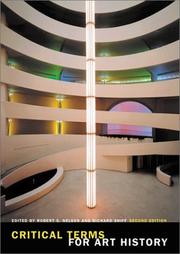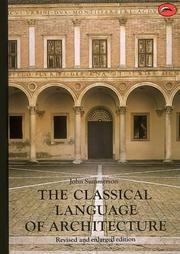| Listing 1 - 6 of 6 |
Sort by
|
Book
ISSN: 07680031 ISBN: 2110809612 9782110809612 2110809620 Year: 1989 Publisher: Paris : Imprimerie Nationale,
Abstract | Keywords | Export | Availability | Bookmark
 Loading...
Loading...Choose an application
- Reference Manager
- EndNote
- RefWorks (Direct export to RefWorks)
Architecture --- Terminology --- Terminologie --- History --- vocabulary --- architectonics --- Vocabulaire --- Dessins et plans --- Détail de construction --- Dictionnaire --- Histoire de l'architecture --- Histoire de la construction --- Patrimoine architectural --- France --- Terminology. --- Dessins et plans. --- Architecture. --- Terminologie. --- Architecture - Terminology

ISBN: 0226571688 0226571661 Year: 2003 Publisher: Chicago The University of Chicago Press
Abstract | Keywords | Export | Availability | Bookmark
 Loading...
Loading...Choose an application
- Reference Manager
- EndNote
- RefWorks (Direct export to RefWorks)
Art --- History as a science --- Aesthetics --- English language --- Anglais (Langue) --- Historiography --- Terminology. --- Terms and phrases. --- Historiographie --- Terminologie --- Mots et locutions --- S38/1700 --- Edited by Robert S. Nelson and Richard Shiff --- kunst --- kunsttheorie --- terminologie --- lexicon --- kunstgeschiedenis --- 7.01 --- Works not related to China and the Far East--Art and archaeology --- Art, Occidental --- Art, Visual --- Art, Western (Western countries) --- Arts, Fine --- Arts, Visual --- Fine arts --- Iconography --- Occidental art --- Visual arts --- Western art (Western countries) --- Arts --- Historiography&delete& --- Terminology --- Terms and phrases --- Art, Primitive --- Germanic languages

ISBN: 0500201773 9780500201770 Year: 1980 Publisher: London Thames
Abstract | Keywords | Export | Availability | Bookmark
 Loading...
Loading...Choose an application
- Reference Manager
- EndNote
- RefWorks (Direct export to RefWorks)
Ce livre constitue sans doute l'introduction la plus claire qui soit à un langage énigmatique pour les non-spécialistes, qui fut pourtant le moyen de communication essentiel des architectes au cours des siècles. Ce langage est celui des ordres classiques, offrant un vocabulaire et des principes essentiels à l'édification des monuments. Lumineux et concis, l'auteur commence par analyser les éléments et les modèles mis en place par les anciens puis envisage les tensions et tranformations dont ce modèle fut l'objet au cours de l'histoire: de sa reconstruction par les génies de la Renaissance à son exaltation par le baroque, du rationalisme des Lumières aux contradictions du néoclassicisme, des curiosités, enfin, de l'éclectisme aux résurgences de cet idiome apparemement désuet chez les maîtres du modernisme.
72.049 --- Architectuur in de klassieke stijl geschiedenis --- Architectuur verschillende onderwerpen --- Architectuurtheorie ; over klassieke architectuur --- Architectuur ; Classicisme --- Architectuur ; Neoclassicisme --- Architectuurtheorie ; klassieke Oudheid --- Architectuur ; theorie, filosofie, esthetica --- Architecture --- -#BIBC:bibl.Reekmans --- 72.01 --- Architecture, Western (Western countries) --- Building design --- Buildings --- Construction --- Western architecture (Western countries) --- 72.01 Architectuurtheorie. Bouwprincipes. Esthetica van de bouwkunst. Filosofie van de bouwkunst --- Architectuurtheorie. Bouwprincipes. Esthetica van de bouwkunst. Filosofie van de bouwkunst --- Terminology --- Design and construction --- classicisme --- semiotics --- architectural theory --- classicism --- architectuurtheorie --- semiotiek --- #BIBC:bibl.Reekmans --- Architectural details --- Details, Architectural --- Architectural design --- Architectural drawing --- Details --- Details. --- Terminology. --- 72.01 Theory and philosophy of architecture. Principles of design, proportion, optical effect --- Theory and philosophy of architecture. Principles of design, proportion, optical effect --- Architectuur ; in de klassieke stijl ; geschiedenis --- Architectuur ; verschillende onderwerpen --- Classicisme --- Architecture classique --- Histoire de l'architecture --- 16e siècle --- Baroque --- Ordre architectural --- Théorie de l'architecture --- CDL --- Architecture - Terminology --- Architecture - Details
Book
ISBN: 9782600014663 2600014667 Year: 2011 Volume: 473 Publisher: Genève : Droz,
Abstract | Keywords | Export | Availability | Bookmark
 Loading...
Loading...Choose an application
- Reference Manager
- EndNote
- RefWorks (Direct export to RefWorks)
Bien que le XVIe siècle ait la réputation tenace d'être propice aux débauches et truculences, il existe assez peu de travaux d’ampleur consacrés à l’analyse de l’obscénité à la Renaissance en France. Etudier l’obscénité à la Renaissance conduit à observer la formation progressive d’une notion qui fait débat parce que les codes moraux et sociaux dont elle dépend ne sont pas encore établis. Le terme d’« obscène » apparaît dans la langue française à cette époque et l’obscénité prolifère dans des contextes très différents, de la médecine à la musique et de la farce aux récits de voyage – autant de lieux où l’obscénité constitue un défi à l’interprétation, puisqu’elle ne peut se définir qu’à partir de ses effets, et qu’elle brouille les limites entre action et représentation. Ainsi la provocation obscène libère une énergie qui permet de repenser l’édiction de normes morales, d’interroger le fonctionnement des œuvres d’art, d’explorer la nature humaine elle-même.
literature [writings] --- humanism --- History of civilization --- Literature --- anno 1500-1599 --- France --- French literature --- Words, Obscene, in literature. --- French language --- Littérature française --- Mots obscènes dans la littérature --- Littérature --- Français (Langue) --- Terminology. --- Obscene words. --- Terminologie --- Mots obscènes --- Words, Obscene, in literature --- Obscene words --- Littérature de la Renaissance. --- Obscénité --- Obscene words in literature. --- Littérature française --- Mots obscènes dans la littérature --- Littérature --- Français (Langue) --- Mots obscènes --- Literary terms --- Langue d'oïl --- Romance languages --- Thematology --- French literature - 16th century --- French literature - 17th century --- Literature - Terminology --- French language - Obscene words --- literature [documents]
Book
ISBN: 9789004329942 9789004393998 9004329943 9004393994 Publisher: Leiden ; Boston : Brill, [2019]
Abstract | Keywords | Export | Availability | Bookmark
 Loading...
Loading...Choose an application
- Reference Manager
- EndNote
- RefWorks (Direct export to RefWorks)
The term ad vivum and its cognates al vivo , au vif , nach dem Leben and naer het leven have been applied since the thirteenth century to depictions designated as from, to or after (the) life. This book explores the issues raised by this vocabulary and related terminology with reference to visual materials produced and used in Europe before 1800, including portraiture, botanical, zoological, medical and topographical images, images of novel and newly discovered phenomena, and likenesses created through direct contact with the object being depicted. The designation ad vivum was not restricted to depictions made directly after the living model, and was often used to advertise the claim of an image to be a faithful likeness or a bearer of reliable information. Viewed as an assertion of accuracy or truth, ad vivum raises a number of fundamental questions in the area of early modern epistemology – questions about the value and prestige of visual and/or physical contiguity between image and original, about the kinds of information which were thought important and dependably transmissible in material form, and about the roles of the artist in that transmission. The recent interest of historians of early modern art in how value and meaning are produced and reproduced by visual materials which do not conform to the definition of art as unique invention, and of historians of science and of art in the visualisation of knowledge, has placed the questions surrounding ad vivum at the centre of their common concerns. Contributors: Thomas Balfe, José Beltrán, Carla Benzan, Eleanor Chan, Robert Felfe, Mechthild Fend, Sachiko Kusukawa, Pieter Martens, Richard Mulholland, Noa Turel, Joanna Woodall, and Daan Van Heesch.
Lexicology. Semantics --- Classical Latin language --- History as a science --- historiography --- visual resources --- graphic arts --- Europe --- Art --- Latin language --- Historiography --- Resemblance (Philosophy) --- Visual communication --- Knowledge, Theory of --- Similarity --- Identity (Philosophical concept) --- Epistemology --- Theory of knowledge --- Philosophy --- Psychology --- Graphic communication --- Imaginal communication --- Pictorial communication --- Communication --- Historical criticism --- History --- Authorship --- Art, Occidental --- Art, Visual --- Art, Western (Western countries) --- Arts, Fine --- Arts, Visual --- Fine arts --- Iconography --- Occidental art --- Visual arts --- Western art (Western countries) --- Arts --- Aesthetics --- Historiography&delete& --- Terminology --- Terms and phrases --- Criticism --- Art, Primitive --- Terminology. --- Terms and phrases. --- History.
Book
ISBN: 211081294X 9782110812940 Year: 1993 Volume: *5 Publisher: Paris : Imprimerie Nationale [Paris],
Abstract | Keywords | Export | Availability | Bookmark
 Loading...
Loading...Choose an application
- Reference Manager
- EndNote
- RefWorks (Direct export to RefWorks)
History --- vocabulary --- Applied arts. Arts and crafts --- glass painting [image-making] --- Glas handwerk --- Glass craft --- Verre [Ouvrage en ] --- Glass painting and staining --- Vitraux --- Terminology. --- Technique. --- Terminologie --- Technique --- Glasramen ; glasschilderkunst ; glas in lood ; naslagwerken --- 748(03) --- Glaskunst ; encyclopedieën --- Glasschilderkunst --- woordenboeken --- woordenboeken. --- Stained glass windows
| Listing 1 - 6 of 6 |
Sort by
|

 Search
Search Feedback
Feedback About
About Help
Help News
News